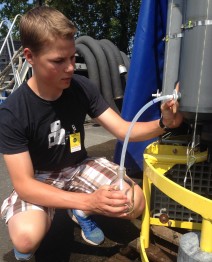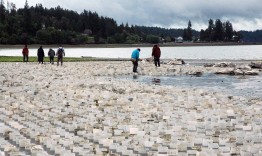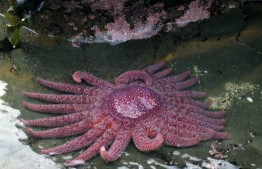EarthEcho International, Philippe Cousteau, Jr.’s environmental education and youth leadership nonprofit, has launched an expedition—called “Acid Apocalypse”—around Washington state to explore the growing threat of ocean acidification and meet with students and scientists to learn how the issue affects their lives. The organization, founded by the grandchildren of legendary explorer Jacques Cousteau, is hosting Google Hangouts while in the field and will produce documentary-style videos, lesson plans, and other resources about ocean acidification for teachers and students.
Read more at UW Today »Oceanography consortium donates XPrize winnings to UW sensor lab
A team of industrial, academic, and nonprofit institutions that was among the top finishers of the recent ocean acidification XPrize is donating its winnings to a University of Washington lab that helps track ocean conditions worldwide. The donation, made Oct. 13 during an event at the UW College of the Environment and announced by Honeywell, will allow the UW and the international Argo program to begin broadening observations to include ocean acidification.
Read more at UW Today »Gear, not geoducks, impacts ecosystem if farming increases
The equipment used to farm geoducks, including PVC pipes and nets, might have a greater impact on the Puget Sound food web than the addition of the clams themselves. That’s one of the findings of the first major scientific study to examine the broad, long-term ecosystem effects of geoduck aquaculture in Puget Sound, published last week in the International Council for the Exploration of the Sea’s Journal of Marine Science.
Read more at UW Today »Bubble plumes off Washington, Oregon suggest warmer ocean releases frozen methane
Warming ocean temperatures a third of a mile below the surface, in a dark ocean in areas with little marine life, might attract scant attention. But this is precisely the depth where frozen pockets of methane ‘ice’ transition from a dormant solid to a powerful greenhouse gas. New University of Washington research, whose lead author is UW professor of oceanography H.
Read more at UW Today »Student collaboration leads to first results describing sick sea star immune response
Though millions of sea stars along the West Coast have perished in the past several years from an apparent wasting disease, scientists still don’t know why. The iconic marine creature develops white lesions on its limbs and within days can dissolve or “melt” into a gooey mass. Last year, researchers identified a type of pathogen known as a densovirus as the likely cause, but they still can’t explain the mass die-off three years ago or why a common ocean virus can wreak havoc on so many starfish species from Alaska to Southern California.
Read more at UW Today »





